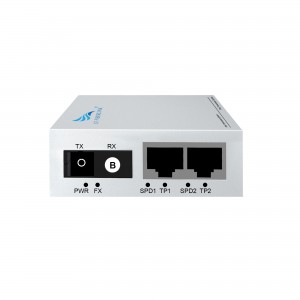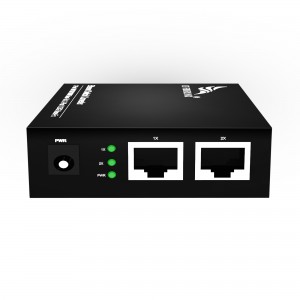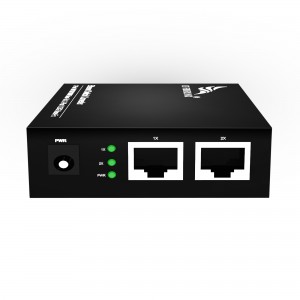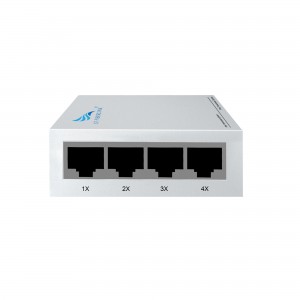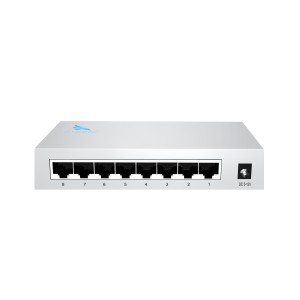5-port 10/100/1000M Media Converter (multi-mode Dual-fiber SC)
5-port 10/100/1000M Media Converter (multi-mode Dual-fiber SC)
Product Features:
Huizhou Changfei Optoelectronics Technology Co., Ltd. launched a breakthrough product, 1 optical 4 electrical multi-mode dual-fiber Gigabit transceiver combined with 5-port Gigabit optical conversion switch. As a leading overall transmission solution provider, Huizhou Changfei is committed to providing innovative and high-quality products and services to global customers. With rich experience in research and development of optoelectronic products and a number of scientific research patents, Huizhou Changfei has won wide acclaim from more than 360 distributors and agents in more than 100 countries around the world.
The product has a wide range of impressive features designed to revolutionize high-speed data transmission. The transceiver and switch combination features a DC5-12V wide-voltage power supply, ensuring reliable performance even under varying power supply conditions. In addition, each port is equipped with 4KV lightning protection to ensure the best protection for connected equipment. The product also performs flawlessly in extreme temperature conditions and is suitable for use in a variety of environments.
This advanced transceiver and switch combination supports 10KB jumbo frames to easily withstand heavy network traffic for seamless connectivity and smooth data transmission. In addition, the product has low power consumption, ensuring energy efficiency and reducing electricity bills.
A 4-digit dial, SC interface and dynamic LED indicators further enhance the user experience and make installation and configuration a breeze. With its plug-and-play functionality, users can easily set up and manage their network without requiring extensive technical knowledge. The sleek iron shell design not only enhances durability, but also helps the product achieve IP30 protection level, ensuring reliable performance even in harsh working environments.
The multimode dual-fiber capability of this transceiver and switch combination makes it versatile, allowing users to connect multiple devices simultaneously. Whether it is for home or office use, this product can provide excellent performance and ensure a stable network connection.
In short, the combination of Huizhou Changfei’s 1-optical, 4-electrical multi-mode dual-fiber gigabit transceiver and 5-port gigabit optical conversion switch is a game-changer in the field of high-speed data transmission. The product has various features such as wide voltage power supply, lightning protection, wide temperature operation, support for jumbo frames, low power consumption, plug and play function, multi-mode dual-fiber function, etc. It is an ideal choice for anyone looking for a reliable and efficient network connect. Trust Huizhou YOFC to take your network performance to a higher level.
What This Product Does
◇ The CF-1024GMW-2 is a media converter designed to convert 1000BASE-X fiber to 1000Base-T copper media or vice versa. Designed under IEEE802.3ab 1000Base-T and IEEE802.3z1000Base-X standards, the CF-1024GMW-2 is designed for use with single-mode fiber cable utilizing the SC-Type connector. The CF-1024GMW-2 supports longwave laser specification at a full wire speed forwarding rate. It works at 1310nm on both transmitting and receiving data.
◇ Other features of this module include the ability to be used as a stand alone device (no chassis required), Auto MDI/MDI-X for TX port, and front panel status LEDs. The CF-1024GMW-2 will transmit at extended fiber optic distances utilizing single-mode fiber up to 2 kilometers.
Other Features
◇ Besides, this media converter can be used as a standalone device (no rack required) or used with CF FIBERLINK’s CF-2U14 rack for auto MDI/MDI-X in TX port in which duplex mode is automatically negotiated.
technical parameter:
| Model | CF-1024GMW-2 | |
| Interface Characteristics | ||
|
Fixed Port |
4* 10/ 100/ 1000Base-T RJ45 port
1* 1000Base-X uplink SC fiber port |
|
| Ethernet Port | 10/ 100/ 1000Base-T auto-sensing, full/half duplex MDI/MDI-X self-adaption | |
|
Twisted Pair Transmission |
10BASE-T: Cat3,4,5 UTP(≤100 meter)
100BASE-T: Cat5e or later UTP(≤100 meter) 1000BASE-T : Cat5e or later UTP(≤100 meter) |
|
| Optical Port | The default optical module is multimode dual fiber 2km, SC port | |
| Wavelength/Distance | multimode: 850nm 0~550M,1310nm 0~2KM | |
| Chip Parameter | ||
| Network Protocol | IEEE802.3 10BASE-T, IEEE802.3i 10Base-T,
IEEE802.3u 100Base-TX, IEEE802.3u 100Base-FX, IEEE802.3x IEEE802.3ab 1000Base-T;IEEE802.3z 1000Base-X; |
|
| Forwarding Mode | Store and Forward(Full Wire Speed) | |
| Switching Capacity | 10Gbps | |
| Buffer Memory | 7.44Mpps | |
| MAC | 2K | |
|
LED Indicator |
Fiber | FX(green) |
| Data | 1X/2X/3X/4X(green) | |
| Power | PWR (green) | |
| Power | ||
| Working Voltage | AC:100-240V | |
| Power Consumption | Standby<1W, Full load<5W | |
| Power Supply | DC:5V/2A industrial power supply | |
| Lightning protection &Certification | ||
| Lightning protection | Lightning protection: 4KV 8/20us, Protection level: IP30 | |
| Certification | CCC;CE mark, commercial; CE/LVD EN60950;FCC Part 15 Class B; RoHS | |
| Physical Parameter | ||
| Operation TEMP | -20~+55°C;5%~90% RH Non condensing | |
| Storage TEMP | -40~+85°C;5%~95% RH Non condensing | |
| Dimension (L*W*H) | 94mm* 71mm*27mm | |
| Installation | Desktop | |
Product Size:
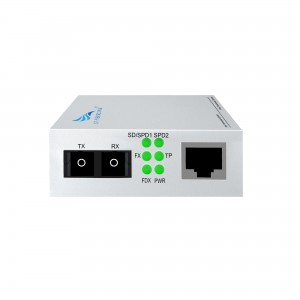
Product application diagra:

How to choose a fiber optic transceiver?
Optical fiber transceivers break the 100-meter limitation of Ethernet cables in data transmission. Relying on high-performance switching chips and large-capacity caches, while truly achieving non-blocking transmission and switching performance, they also provide balanced traffic, isolation and conflict. Error detection and other functions ensure high security and stability during data transmission. Therefore, fiber optic transceiver products will still be an indispensable part of actual network construction for a long time. So, how should we choose fiber optic transceivers?
1. Port function test
Mainly test whether each port can work normally in the duplex state of 10Mbps, 100Mbps and half-duplex state. At the same time, it should be tested whether each port can automatically select the highest transmission speed and automatically match the transmission rate of other devices. This test can be included in other tests.
2. Compatibility test
It mainly tests the connection ability between the optical fiber transceiver and other devices compatible with Ethernet and Fast Ethernet (including network card, HUB, Switch, optical network card, and optical switch). The requirement must be able to support the connection of compatible products.
3. Cable connection characteristics
Test the fiber optic transceiver’s ability to support network cables. First, test the connection ability of Category 5 network cables with lengths of 100m and 10m, and test the connection ability of long Category 5 network cables (120m) of different brands. During the test, the optical port of the transceiver is required to have a connection capability of 10Mbps and a rate of 100Mbps, and the highest must be able to connect to a full-duplex 100Mbps without transmission errors. Category 3 twisted pair cables may not be tested. Subtests can be included in other tests.
4. Transmission characteristics (transmission loss rate of data packets of different lengths, transmission speed)
It mainly tests the packet loss rate when the optical fiber transceiver optical port transmits different data packets, and the connection speed under different connection rates. For the packet loss rate, you can use the test software provided by the network card to test the packet loss rate when the packet size is 64, 512, 1518, 128 (optional) and 1000 (optional) bytes under different connection rates. , the number of packet errors, the number of packets sent and received must be more than 2,000,000. Test transmission speed can use perform3, ping and other software.
5. The compatibility of the whole machine to the transmission network protocol
It mainly tests the compatibility of fiber optic transceivers to network protocols, which can be tested in Novell, Windows and other environments. The following low-level network protocols such as TCP/IP, IPX, NETBIOS, DHCP, etc. must be tested, and the protocols that need to be broadcast must be tested. Optical transceivers are required to support these protocols (VLAN, QOS, COS, etc.).
6. Indicator status test
Test whether the status of the indicator light is consistent with the description of the panel and the user manual, and whether it is consistent with the current status of the fiber optic transceiver.








